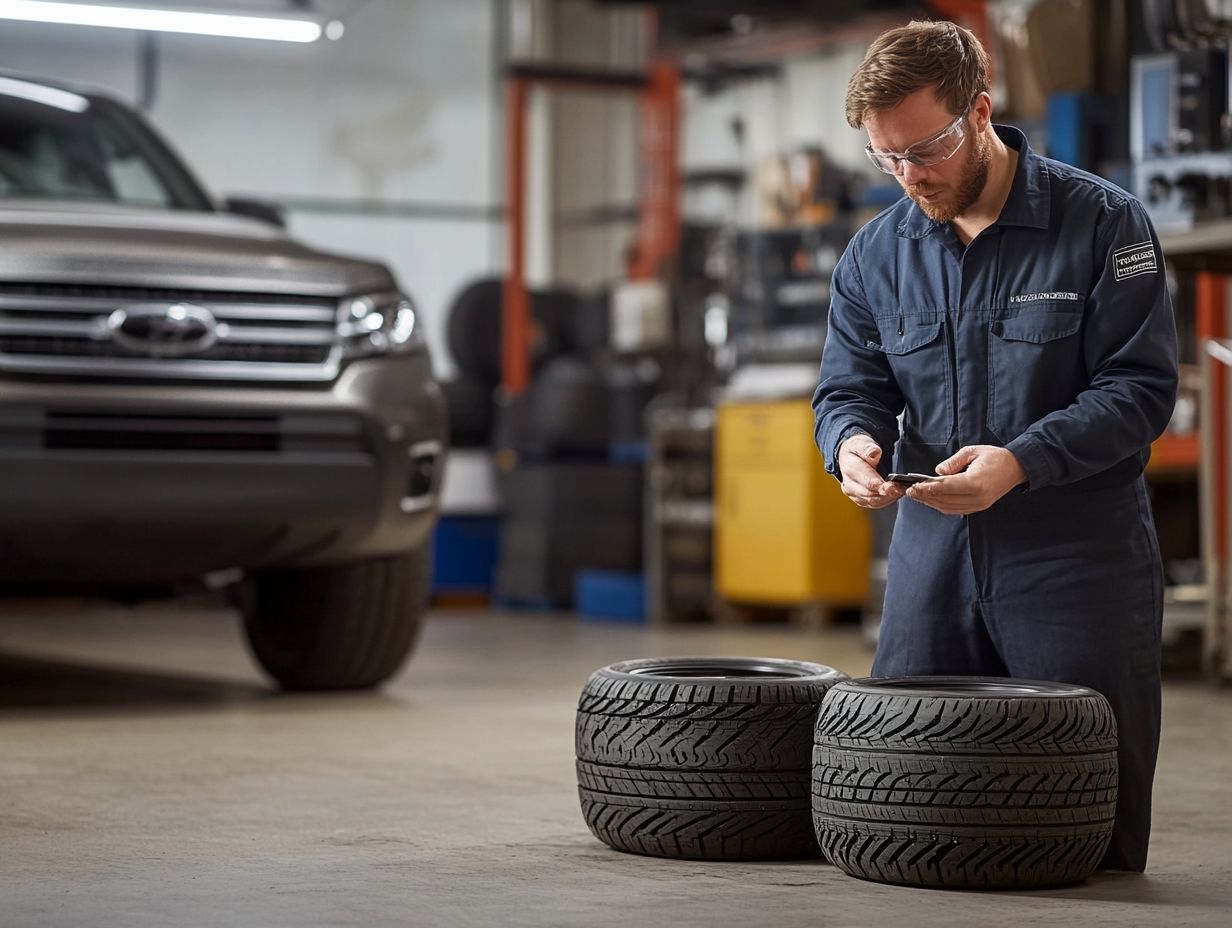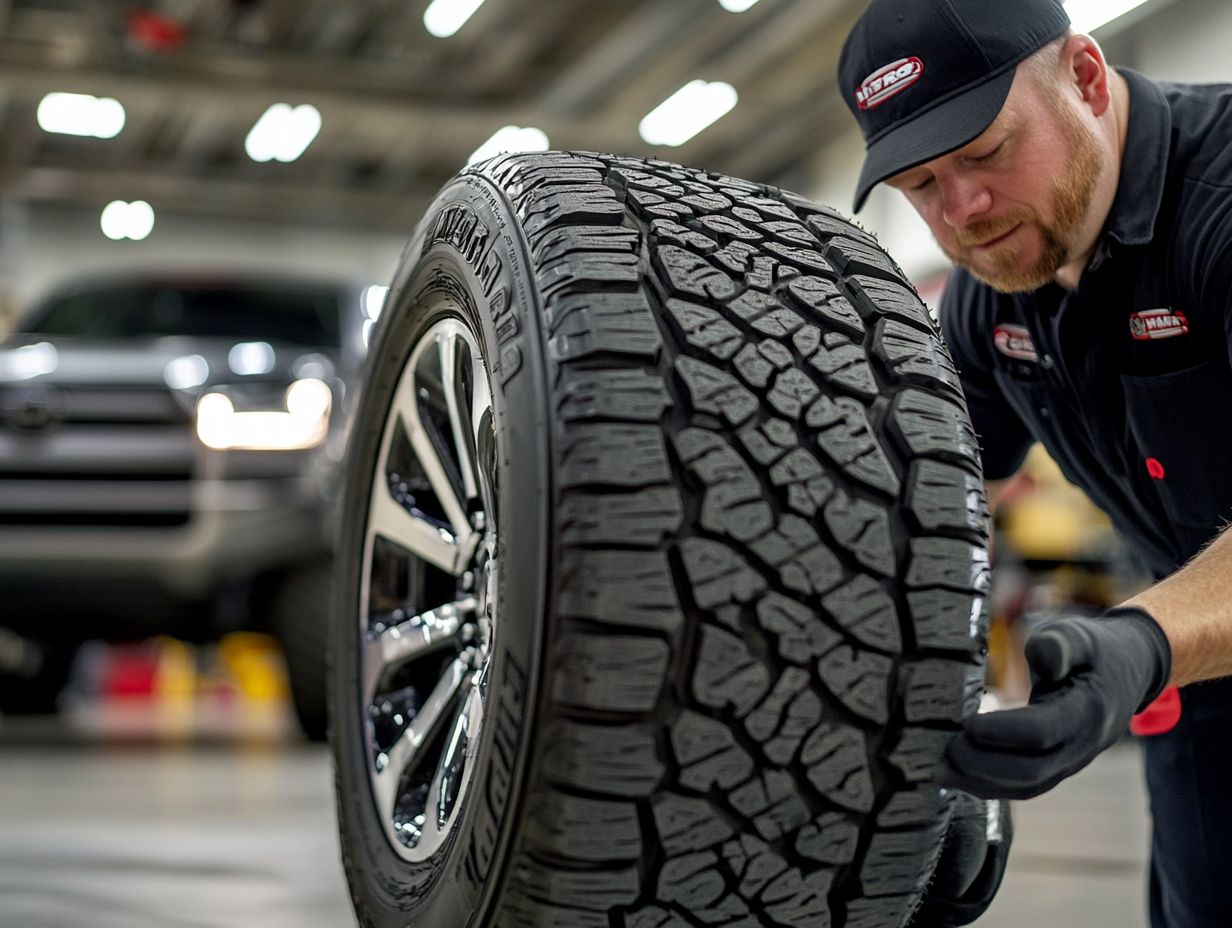How to Choose the Right Tires for Your Vehicle?
Choosing the right tires for your vehicle is paramount for ensuring safety and enhancing performance. It also maximizes your comfort on the road.
With the vast selection of tire types and functions available, navigating this terrain can feel daunting. This guide will illuminate essential factors you need to consider, including your vehicle s specifications and your unique driving habits.
You ll discover suitable tire options for various vehicles. You will also learn how to decode those seemingly cryptic tire labels. This guide also provides essential safety tips and guidance on selecting tires tailored for different weather conditions.
Get ready to hit the road with newfound confidence and safety!
Contents
- Key Takeaways:
- Understanding Tire Basics
- Factors to Consider When Choosing Tires
- Types of Tires for Different Vehicles
- How to Determine the Right Tire Size
- Tire Safety and Maintenance
- Choosing the Right Tires for Different Weather Conditions
- Frequently Asked Questions
- What factors should I consider when choosing the right tires for my vehicle?
- How do I determine the right tire size for my vehicle?
- What are the different types of tires available and which one is best for my vehicle?
- How can I tell if my tires need to be replaced?
- What is the importance of tire maintenance?
- Can I mix different types of tires on my vehicle?
Key Takeaways:

- Learn the basics of tires to choose the right ones for your vehicle.
- Consider your vehicle specifications and driving habits for optimal performance and safety.
- Choose the right tire size by reading tire labels and codes. Prioritize tire safety and maintenance for proper inflation and rotation.
Understanding Tire Basics
Grasping the fundamentals of tires is essential for every vehicle owner. Tires represent the sole connection between your vehicle and the road.
Recognize that different types of tires winter tires, summer tires, and all-season tires are designed for specific functions. They excel under varying driving conditions.
Choosing the right tire can significantly enhance your safety, performance, and fuel economy. It can also prolong tire lifespan and ensure superior handling. Therefore, understanding the technology behind these vital components is not just beneficial; it s imperative.
Tire Types and Their Functions
Tire types play a pivotal role in shaping your vehicle’s performance and safety. For instance, winter tires are designed for better grip in snow and ice. Summer tires are crafted for warm weather, while all-season tires provide versatile functionality that adapts to various driving needs.
These distinct categories are carefully designed with unique tread patterns that significantly influence traction, handling, and your overall driving experience.
For example, winter tires have deeper grooves and softer rubber compounds, enhancing grip on slippery surfaces. This feature is essential for those living in regions with harsh winters.
Conversely, summer tires feature a flatter tread pattern that maximizes road contact, ensuring exceptional performance and stability whether it s dry or wet. All-season tires strike a balance between the advantages of both summer and winter tires, delivering dependable performance throughout the year, though they may compromise in extreme conditions.
Factors to Consider When Choosing Tires
Selecting the perfect tires for your vehicle demands a thoughtful evaluation of various factors. Consider the climate in which you typically drive, your individual driving habits, and the performance characteristics that matter most to you.
Each of these elements plays a crucial role in enhancing your overall safety and optimizing fuel economy during your journeys.
Vehicle Specifications and Driving Habits
Understanding your vehicle’s specifications is essential when selecting tires. Your unique driving habits also influence safety, handling, and your overall driving experience.
The size and weight of your vehicle are critical in determining the right type of tires. Larger and heavier models require tires that support their mass while ensuring stability across various surfaces.
Your driving style affects tire performance needs. If you’re an aggressive driver, you’ll want tires that provide enhanced grip and responsiveness for sharp maneuvers. Conversely, if you prefer a more leisurely approach, comfort and fuel efficiency may take precedence.
By harmonizing these elements, you can ensure a safer and more enjoyable ride, perfectly tailored to your personal preferences and your vehicle’s capabilities.
Types of Tires for Different Vehicles

Different types of vehicles, including trucks, cars, and SUVs, demand specific tire types to enhance both performance and safety. Whether you re opting for winter tires, summer tires, or all-season tires, each is designed to meet the unique conditions and driving styles you encounter.
Choosing the right tire is vital for a smooth and safe ride!
Suitable Tires for Cars, Trucks, and SUVs
When selecting tires, you must carefully consider the unique needs of your car, truck, or SUV. Each vehicle type has its own performance characteristics and safety features that ensure optimal traction and handling.
For cars, the focus is typically on agility and fuel efficiency. You ll want tires that enhance grip on paved roads while delivering a smooth, comfortable ride.
Trucks often need sturdier tires designed to handle heavier loads and off-road adventures, emphasizing durability and traction in various conditions.
As for SUVs, they blend the best of both worlds, necessitating tires that strike a balance between on-road comfort and off-road capability. This balance is essential for maintaining stability and safety across diverse environments.
The right tire choice can profoundly influence your vehicle’s maneuverability, impacting crucial aspects such as braking distance and cornering performance factors that are vital for a safe driving experience.
How to Determine the Right Tire Size
Determining the right tire size for your vehicle is paramount for ensuring both safety and performance. It requires a keen understanding of essential specifications, such as load index, how well the tire handles heat, and tread design.
Paying attention to these details will help you achieve optimal driving conditions, enhancing your overall experience on the road.
Reading Tire Labels and Codes
Reading tire labels and codes is crucial for grasping the specifications that influence your tire’s performance, safety, and compatibility with your vehicle. This includes essential details like size and load index.
Arming yourself with this knowledge not only helps you select the right tires but also elevates your overall driving experience. For instance, the tire size, typically expressed as a combination of numbers and letters, reveals valuable information regarding the tire’s width, aspect ratio, and construction type.
The load index indicates the maximum weight each tire can safely carry, while the speed rating informs you of how fast the tire can safely operate under load.
By understanding these components, you empower yourself to make informed decisions, ensuring that your driving experience is both optimal and safe on the road.
Tire Safety and Maintenance
Tire safety and maintenance are paramount to your vehicle’s performance. By conducting regular inspections, ensuring proper inflation, and adhering to timely rotation schedules, you can significantly extend the lifespan of your tires while enhancing your safety on the road.
Proper Inflation and Rotation

Proper tire inflation and rotation are essential maintenance practices that you should prioritize, as they enhance safety and prolong the life of your tires by ensuring even wear and optimal performance.
Maintaining the correct tire pressure is crucial. Under-inflated tires can lead to decreased fuel efficiency and increased braking distances, while over-inflation may cause premature wear in the center of the tread.
To address these issues, it’s advisable for you to check your tire pressure at least once a month and before long trips, using a reliable gauge.
Establishing a regular tire rotation schedule, typically every 5,000 to 7,500 miles, ensures that your tires wear evenly, maximizing their lifespan. By following these practices, you can maintain not only your vehicle’s performance but also your safety on the road.
Remember to regularly check your tires and consult a professional if you have any questions!
Choosing the Right Tires for Different Weather Conditions
Selecting the appropriate tires for different weather conditions is crucial for your vehicle’s safety and performance.
Winter tires shine in cold and snowy climates, providing superior traction. Summer tires are engineered for warmer conditions, ensuring optimal handling.
All-season tires present a reliable compromise for moderate climates, balancing performance across various conditions. Make the right choice to enhance your driving experience and safety on the road.
Winter, Summer, and All-Season Tires
Winter tires are crafted to deliver great grip and handling in snowy conditions. Summer tires excel in warm weather, offering superior performance.
Winter tires have deep, wide grooves and specialized rubber compounds that remain pliable in low temperatures, ensuring maximum grip on icy surfaces. In contrast, summer tires are designed with a sleek tread pattern, which is the design on the tire that affects grip, enhancing road contact for exceptional responsiveness and shorter braking distances in dry and wet conditions.
All-season tires feature moderate tread designs that can handle light snow and deliver decent performance year-round. However, they may not match the effectiveness of dedicated winter or summer tires when faced with extreme weather conditions.
Frequently Asked Questions
What factors should I consider when choosing the right tires for my vehicle?
When choosing tires, consider the type of vehicle you have, the climate you live in, your driving style, and the terrain you typically drive on.
How do I determine the right tire size for my vehicle?

The best way to determine the right tire size is by checking the tires currently on your car or consulting your vehicle’s owner’s manual. You can also find this information on the inside of your driver’s side door.
What are the different types of tires available and which one is best for my vehicle?
The main types of tires are all-season, winter, all-terrain, and performance. The best one for your vehicle depends on your driving needs and the climate you live in. Consult with a tire specialist to determine the best type for your specific vehicle.
How can I tell if my tires need to be replaced?
There are a few signs your tires may need to be replaced, including low tread depth, cracks or bulges on the sidewall, and uneven wear. Make sure to replace your tires every 6 years to stay safe on the road!
What is the importance of tire maintenance?
Proper tire maintenance, such as regular rotation and inflation, is crucial! It helps extend the life of your tires and improve overall safety and performance. It is recommended to have your tires checked by a professional at least once a year.
Can I mix different types of tires on my vehicle?
It is not recommended to mix different types of tires on your vehicle, as it can affect handling and stability. Stick with tires of the same type, size, and tread pattern for optimal performance and safety.






